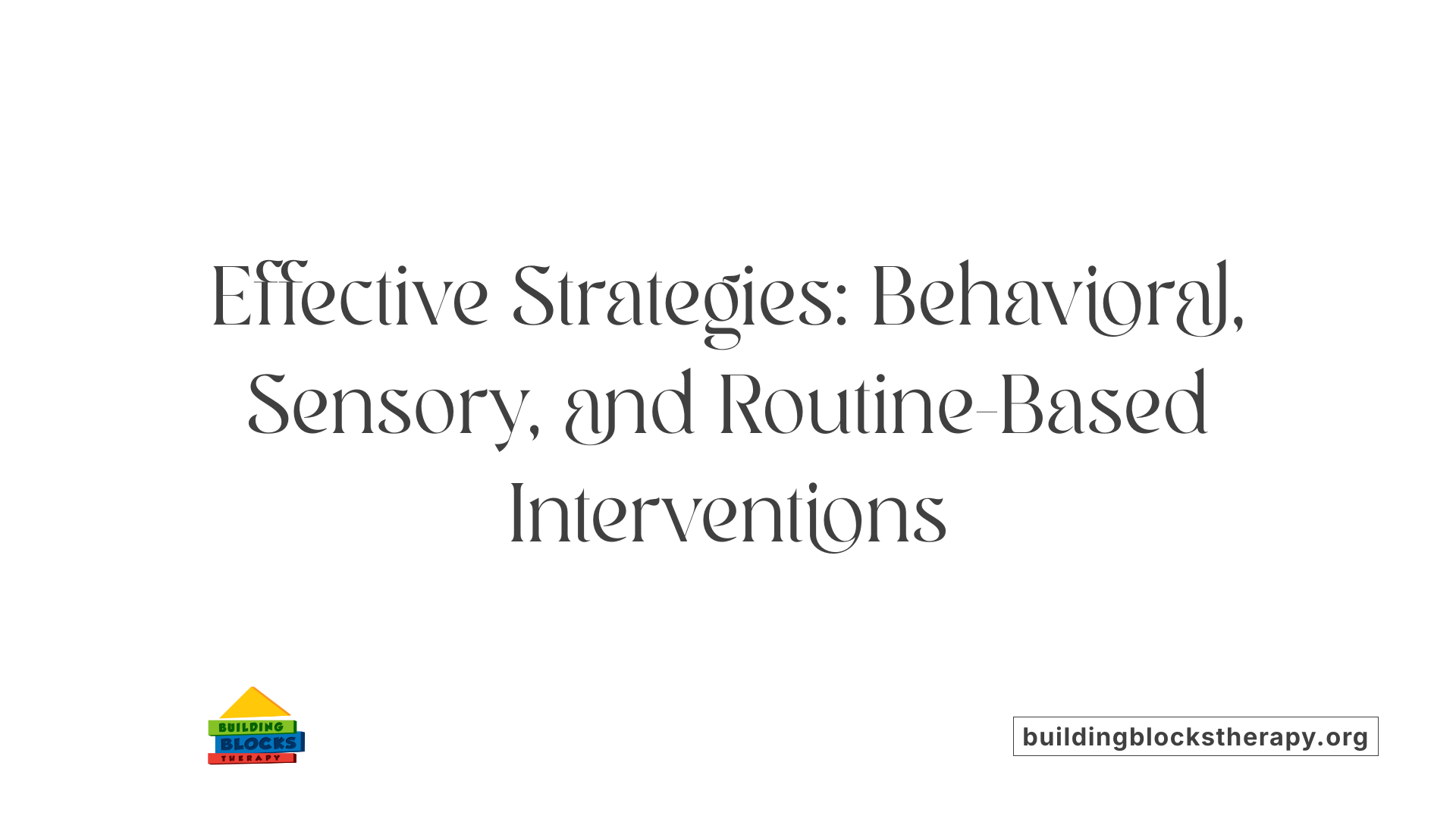Addressing Picky Eating in Autism
Understanding and Managing Sensory-Driven Picky Eating in Autism

Introduction to Picky Eating in Autism
Picky eating is a common challenge among children on the autism spectrum, impacting their nutritional intake, social interactions, and family dynamics. With studies indicating that 50% to 89% of autistic children experience feeding problems, understanding the causes and effective interventions is crucial for caregivers and professionals alike.
Prevalence and Impact of Picky Eating in Autism
 Children with autism are significantly more prone to mealtime challenges compared to their neurotypical peers. Research shows that between 50% and 89% of children on the spectrum experience some form of feeding difficulty, including selective eating, food refusal, and other disordered eating behaviors. These issues are not only common but also impactful, influencing nutritional intake, social interactions, and family routines.
Children with autism are significantly more prone to mealtime challenges compared to their neurotypical peers. Research shows that between 50% and 89% of children on the spectrum experience some form of feeding difficulty, including selective eating, food refusal, and other disordered eating behaviors. These issues are not only common but also impactful, influencing nutritional intake, social interactions, and family routines.
A recent study within the SPARK autism project indicates that approximately 16% of autistic children have a diagnosed feeding disorder, while one in five are at high risk for avoidant/restrictive food intake disorder (ARFID). These statistics highlight the frequency and seriousness of the problem.
Many autistic children prefer limited food groups, often avoiding fruits, vegetables, dairy, and whole grains. Their diets tend to be rich in processed foods, fried items, and sweets, reflecting sensory sensitivities to taste, texture, and smell. For example, some children may prefer soft foods like mashed potatoes or yogurt, while others gravitate toward crunchy snacks like chips or fried chicken.
The effects of picky eating extend beyond nutrition. It can lead to nutritional deficiencies, gastrointestinal issues such as constipation or acid reflux, and social difficulties during family meals. Food rituals, such as refusing foods that touch or requiring specific presentation, further limit dietary variety.
Addressing these difficulties is critical, as proper nutrition supports growth, cognitive development, and overall health. Early intervention through behavioral, sensory, and medical approaches can help expand food choices and improve mealtime experiences for children with autism.
| Aspect | Details | Additional Points |
|---|---|---|
| Prevalence | 50% to 89% face feeding challenges | Many children maintain selective diets into adolescence and adulthood |
| Common foods avoided | Vegetables, fruits, dairy, whole grains | Preference for processed, fried, or starchy foods |
| Associated issues | Nutritional deficiencies, GI problems | Food rituals, sensory sensitivities |
| Impact | Social and family meal difficulties | Potential long-term health consequences |
| Interventions | Behavioral therapy, sensory strategies, medical consultation | Early support enhances outcomes |
Understanding the widespread nature of picky eating in autism, along with its causes—from sensory sensitivities to medical issues—is vital for parents, caregivers, and clinicians. Employing targeted strategies can significantly improve dietary variety and mealtime harmony, ensuring healthier development and better quality of life for autistic individuals.
Sensory and Oral Motor Contributions to Picky Eating

What causes picky eating in children with autism?
Picky eating in children with autism is often driven by sensory processing issues, such as hypersensitivity to textures, smells, and colors, as well as oral motor delays affecting chewing and swallowing. Past negative food experiences can reinforce food aversions, and a natural cautiousness to unfamiliar foods results from core autism traits like intolerance to change and sensory overload. Medical conditions, including gastrointestinal discomfort and nutrient deficiencies, can exacerbate food refusal behaviors, creating a complex interplay of sensory, physiological, and psychological factors that influence eating choices.
How do sensory sensitivities impact food acceptance?
Sensory sensitivities play a significant role in food acceptance among children with autism. Many have preferences for certain textures—such as soft or crunchy—and may be averse to others that feel or smell unfamiliar or unpleasant. These sensitivities can lead to discomfort, gagging, or emotional distress during meals, often resulting in highly limited diets that focus only on safe, sensory-friendly foods. Recognizing these sensitivities allows caregivers to adapt feeding strategies, gradually introducing a greater variety of textures and flavors in a supportive manner. This process can help reduce mealtime stress and encourage broader food acceptance.
What role do oral motor delays play in picky eating?
Oral motor delays are common in children with autism and involve underdeveloped muscles used for chewing and swallowing. These difficulties can make certain foods—especially chewy or textured ones—hard or unpleasant to eat, which reinforces a limited diet. For example, weak jaw muscles may cause discomfort when biting into meat or hard vegetables.
Targeted therapies focusing on oral motor development can help improve these skills. Strengthening oral musculature gradually allows children to handle a wider range of foods, promoting nutritional intake and expanding dietary options.
How do texture and taste preferences develop in autistic children?
Texture and taste preferences in children with autism develop largely due to their sensory processing traits. Many develop strong preferences for foods that feel a specific way in their mouths, such as soft, smooth foods or crunchy snacks, to minimize sensory overload. These preferences might be reinforced by their sensitivities, previous negative experiences, or physiological factors like weak jaw muscles.
Understanding these development patterns helps caregivers and professionals to introduce new foods thoughtfully. Using gradual, sensory-friendly approaches ensures that children feel safe and comfortable, which encourages them to try new textures and flavors over time.
| Factors Influencing Food Preferences | Description | Additional Notes |
|---|---|---|
| Sensory sensitivities | Reaction to textures, smells, tastes, and visual appearance | Leads to limited diet and selective eating |
| Oral motor capabilities | Strength and coordination of muscles involved in eating | Affects ability to chew and swallow various foods |
| Past food experiences | Negative or overwhelming encounters | Reinforces food aversions |
| Autism traits | Need for routine, intolerance to change | Fuels cautiousness around new foods |
| Physiological issues | Gastrointestinal discomfort, nutrient deficiencies | Impact willingness to eat and food choices |
Understanding these aspects provides a comprehensive picture of how sensory and oral motor factors contribute to picky eating in children with autism. Tailored interventions can address these specific challenges, improving mealtime experiences and dietary diversity.
Therapeutic and Behavioral Interventions for Mealtime Challenges

What therapeutic approaches are effective for expanding food preferences?
Applying targeted therapies can significantly improve eating habits in children with autism. One of the most prominent approaches is Applied Behavior Analysis (ABA), which offers specific strategies to encourage dietary variety. ABA therapists utilize techniques like systematic desensitization, gradually introducing new foods to lessen anxiety around eating. Visual supports, such as picture schedules or communication cards, help children understand and anticipate mealtime expectations, reinforcing positive behaviors.
Turning meals into predictable, structured routines stabilizes mealtime experiences, reducing resistance and anxiety. Play-based approaches that incorporate fun into eating, alongside modeling healthy eating behaviors by parents or caregivers, are also very effective. Reinforcing small successes with preferred rewards encourages children to try new foods and gradually expand their diet. Overall, ABA techniques focus on building positive associations with diverse foods and establishing mealtime habits that promote long-term dietary improvements.
How can routines and positive reinforcement improve mealtime experiences?
Consistency is vital for children with autism to feel secure during mealtimes. Establishing a regular schedule for meals and snacks helps children anticipate what to expect, reducing anxiety and behavioral outbursts. Routine meals turn eating into a familiar and comfortable activity, which can motivate children to participate willingly.
Using positive reinforcement, such as verbal praise, stickers, or access to preferred activities, encourages children to try new foods or behave appropriately during meals. For example, praising a child for attempting a new food or sitting calmly at the table reinforces these behaviors and promotes their repetition.
Over time, these combined strategies foster confidence and make mealtimes more pleasant. This supportive environment reduces power struggles and increases the likelihood of developing healthy and diverse eating habits, contributing to overall well-being and nutritional health.
What are some practical strategies for addressing mealtime behavioral issues?
Managing mealtime behaviors involves patience, structure, and consistency. Starting small by offering one familiar food at a time minimizes overwhelm and builds trust. Praise even minor successes, such as touching or tasting a new food, to motivate continued efforts.
Creating a calm environment is crucial. Minimizing distractions like screens or toys allows the child's focus to be on eating, which can reduce refusals and disruptive behaviors. Visual aids, such as social stories or visual schedules, prepare children for what to expect and can reduce anxiety about mealtime routines.
Using timers or cues to encourage children to stay seated and eat at the table can reinforce desired behaviors. Consistently applying these strategies, along with support from professionals such as therapists or behavior analysts, can lead to improved mealtime behaviors. Remember that patience and persistence are vital, and progress may be gradual but steady with consistent effort.
Medical and Nutritional Considerations in Autism Feeding Difficulties
What medical conditions should be assessed in children with picky eating?
Children with picky eating, especially those on the autism spectrum, should undergo thorough medical evaluations to identify underlying issues that could influence their eating behaviors. Common conditions include gastrointestinal problems such as acid reflux, constipation, eosinophilic esophagitis (EoE), and food allergies or sensitivities. These issues can cause discomfort or pain, leading to food avoidance or selective eating.
Dental health and oral pain should also be checked, as problems like tooth decay or oral infections can make eating unpleasant. Additionally, delayed oral motor skills—difficulties with chewing, swallowing, or coordinating mouth movements—are often observed in children with autism and can restrict diet variety.
Consulting a pediatric gastroenterologist is essential for diagnosing these physiological conditions. This professional assessment helps develop targeted treatments, which may include medication, dietary adjustments, or interventions for oral-motor skills. Addressing medical concerns is vital to improve appetite, reduce mealtime distress, and ensure adequate nutrition.
What nutritional deficiencies are common in children with autism, and how can they be addressed?
Limited diets driven by sensory sensitivities and food aversions often lead children with autism to have nutritional deficiencies. Commonly observed deficiencies include zinc, iron, vitamins A, D, and K, calcium, magnesium, fiber, potassium, and choline.
These deficiencies can affect growth, immune function, neurological development, and overall health. For example, low zinc levels may exacerbate picky eating behaviors, while iron deficiency can impair cognitive function.
Addressing deficiencies involves monitoring nutritional status through regular blood work and diet assessments. Healthcare providers may recommend personalized supplementation—zinc, iron, or vitamin D supplements—to correct specific deficiencies. Incorporating nutrient-dense foods such as fortified cereals, colorful vegetables, lean meats, and dairy can help improve intake.
Because nutritional needs vary among children, guidance from registered dietitians ensures a tailored plan emphasizing balanced eating patterns and appropriate supplementation when necessary.
When is medical intervention necessary for feeding problems?
Medical intervention becomes necessary when feeding problems significantly impact a child’s health and development. Indicators include persistent weight loss, severe nutritional deficiencies, and high levels of anxiety or distress associated with eating.
Other signs demanding prompt medical attention involve extremely limited diets that restrict essential nutrients, difficulty swallowing, pain during meals, or gastrointestinal issues like chronic constipation or reflux.
Children displaying unsafe eating behaviors—such as gagging, choking, or refusing entire food groups—should be evaluated by healthcare professionals, including pediatricians, gastroenterologists, and dietitians. Early intervention helps prevent long-term health issues, supports healthy growth, and reduces mealtime conflicts.
Overall, a comprehensive approach combining medical, nutritional, and behavioral strategies can effectively address feeding challenges, promoting healthier eating habits and better quality of life for children with autism.
| Aspect | Details | Additional Notes |
|---|---|---|
| Medical concerns | GI issues, dental health, oral-motor delays | Use specialist assessments for targeted treatment |
| Nutritional deficiencies | Zinc, iron, vitamins A, D, K, calcium, magnesium | Supplements and diet modifications essential |
| When to seek intervention | Weight loss, severe distress, malnutrition, unsafe eating | Early specialist involvement critical |
Understanding and managing these medical and nutritional factors are crucial to helping children with autism develop healthy eating habits and improved overall health.
Resources and Support for Caregivers

What resources are available for parents managing picky eating?
Parents navigating the challenges of picky eating in children with autism have access to a variety of helpful resources. Support groups and online communities play a vital role in sharing experiences, providing encouragement, and exchanging practical advice. These platforms create a space where caregivers can discuss specific issues, learn from others, and find emotional backing.
Educational materials are also invaluable. Organizations like Autism Speaks offer comprehensive guides and evidence-based strategies that assist in managing mealtime behaviors and expanding dietary variety. These resources often include detailed approaches for implementing routine-based feeding practices and reducing anxiety around food.
Meal planning tools, such as apps and visual recipes, help create appealing and manageable menus tailored to sensory preferences. These tools enable parents to plan meals that are appealing and nutritionally balanced while respecting individual sensitivities.
Consulting with healthcare professionals—such as dietitians, occupational therapists, and behavior analysts—provides personalized support. These experts can develop tailored interventions focusing on sensory integration, oral motor skills, and behavioral strategies, helping to improve a child's eating habits.
By leveraging these resources, caregivers gain confidence and knowledge, enabling them to adopt consistent, patient approaches. The goal is to foster a positive mealtime environment where children can explore new foods gradually and safely, leading to healthier eating patterns over time.
How can professional support aid in addressing picky eating?
Professional intervention is crucial in effectively managing picky eating among children with autism. Multidisciplinary teams, including speech therapists, occupational therapists, board-certified behavior analysts (BCBAs), and dietitians, conduct comprehensive assessments to identify underlying causes such as sensory processing issues, oral motor delays, or behavioral challenges.
These experts develop targeted treatment plans that may incorporate sensory integration therapy, oral motor exercises, and applied behavior analysis (ABA) strategies. For instance, gradual food exposure techniques, routine establishment, and positive reinforcement can help expand food preferences.
Regular collaboration with professionals ensures ongoing monitoring of progress and allows for adjustments in intervention strategies to optimize outcomes. This expert guidance enhances parental efforts, increases the likelihood of success, and helps create a positive, less stressful mealtime experience.
Overall, professional support complements family efforts by providing specialized techniques, fostering consistency, and helping children develop healthier eating behaviors, which can significantly improve their nutritional health and quality of life.
Additional Support Resources
| Resource Type | Description | How It Helps |
|---|---|---|
| Support Groups | Local and online communities for families | Emotional support, shared experiences, practical advice |
| Educational Resources | Guides from organizations like Autism Speaks | Evidence-based feeding strategies |
| Meal Planning Apps | Visual recipes, scheduling tools | Manageable, appealing meal preparation |
| Professional Consultations | Dietitians, OTs, BCBAs | Personalized interventions, professional guidance |
Searching for More Information
You can explore further resources by searching for: "Support and Resources for Managing Autism Feeding Difficulties." Utilizing these various supports and tools can empower caregivers to better address the challenges of picky eating, promoting healthier, more enjoyable mealtimes for children with autism.
Final Thoughts and Moving Forward
Addressing picky eating in children with autism is a multifaceted process that requires understanding, patience, and a tailored approach. Caregivers should focus on creating supportive routines, consulting healthcare professionals, and employing evidence-based behavioral and sensory strategies. With consistent effort and professional guidance, it is possible to expand dietary variety, improve mealtime experiences, and support the overall health and development of children on the spectrum. Ongoing research and resource availability continue to enhance these efforts, offering hope for more effective interventions in the future.
References
- Autism and food aversions: 7 Ways to help a picky eater
- Autism and Picky Eating - Child Mind Institute
- Avoid Distress At Mealtime: 7 Strategies For Autism And Picky Eating
- Feeding and eating problems in children and adolescents with autism
- Very Picky Eating in Children with Autism - SPARK for Autism
- Picky Eating and Autism
- How to Help Your Child with Autism Overcome Picky Eating
- Autism and eating - BeyondAutism






